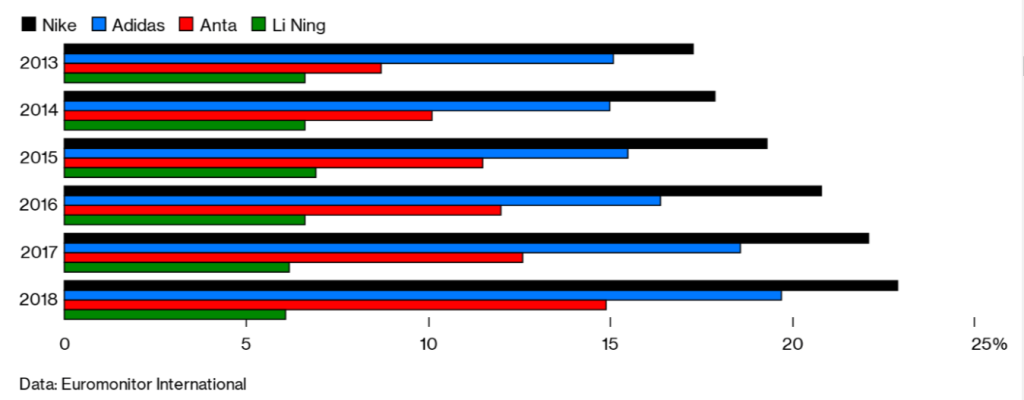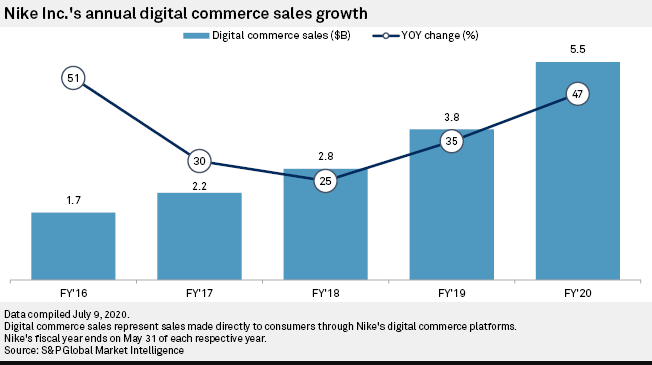Guide
PESTLE Analysis of Nike

A PESTEL analysis of NIKE will teach you how the business of the brand is affected by the macro-environmental factors that are present in the industry. A PESTEL business study is a framework that helps business owners and others in business understand the impact that macroenvironmental factors have on their company.
The abbreviation PESTEL refers to the following categories: political, economic, social, technological, and environmental and legal. Discover what the PESTEL framework is and how it might benefit your company by reading this article. NIKE is the company that produces the most athletic shoes in the world. According to estimates provided by analysts within the sector, the corporation presently controls 28% of the market.
In the year 2020, the company’s worldwide sales were approximately 37.4 billion dollars worth in US currency. Let’s use the PESTEL framework to conduct an analysis of the macroenvironment in which Nike operates.
Read Also: Cage Analysis of Nike
PESTLE analysis of Nike
Political factors
The political elements provide the entrepreneur with information that assists them in evaluating the extent to which a government intervenes in the economy or a particular industry and how the policies of that government affect the company’s operations both now and in the future.
In general, the government of the United States has produced various programmes that are focused on expansion. The United States of America is one of Nike’s most important markets, since the country is expected to contribute around 41% of the company’s total sales in 2019.
5151 people are employed across 36 plants in the United States to produce Nike footwear. Nike has 517 manufacturing sites located in 41 different countries so that the company can expand into new markets and take advantage of additional commercial opportunities.
China and Vietnam account for 108 of the company’s manufacturing locations, with Indonesia and Thailand coming in second and third, respectively. With sales expected to increase by 22% in 2019, China is one of the most important markets for Nike.
Because Nike is a multinational corporation, it is required to take into consideration the tariffs that apply to the sale of its shoes and other products. Shoe companies in the United States, for instance, are subject to tariffs that can reach as high as 25 percent, making it one of the industries with the highest taxes.
The trade tensions between the United States and China began to intensify in 2019, when President Trump promised to hike taxes on Chinese imports by 10%. These levies would apply to all types of footwear, ranging from sneakers to sandals. It was anticipated that the tariffs will add an additional $7 billion in annual expenses to the bills of American consumers.
Experts in the field stated that the corporation would have been minimally impacted by the hike in tariffs due to the fact that only ten percent of the products that Nike manufactures in China are sold in the United States market.
In addition to this, it has broadened its supply chain by establishing production facilities in a number of other nations on the Asian continent, including Vietnam, Indonesia, and Thailand. That was a wise choice in business that has protected the massive shoe manufacturer from the negative repercussions on their bottom line that come with holding political power.
The answer, according to Nike, is a supply network that spans multiple locations.

Economical factors
According to the PESTEL framework, the performance of the economy is determined by the economic factors, which include the rate of economic growth, the exchange rate, the interest rate, the unemployment rate, the state of the country’s infrastructure, and the tax rate.
The purchasing power of customers is impacted by this element, which has the potential to alter the demand and supply dynamics of the market. Which ultimately has an effect on the prices of the various goods and services.
Has the economic crisis of 2008 have any effect on the large sportswear company?
Yes, it did. Because consumers were having trouble making ends meet as a result of job loss and declining earnings, sales dropped by 12%. In addition, the shares of the corporation dropped by as much as 28%.
In order to adjust to the new environment, Nike has implemented a costly reorganisation that has resulted in the corporation laying off 5% of its staff and experiencing the largest drop in employment in the history of the company. While many other companies fell under, Nike was able to persevere.
After the economic downturn was resolved, there was a significant improvement in both sales and stock.
“When times are tough economically, customers will turn to companies that they are familiar with and to which they feel a connection. “We have not seen the economy have a significant impact on the sales of our products, not just in the high end, but also in the mid-priced range,” Chief Executive Mark Parker said at the time. “We have not seen the economy have a dramatic impact on the sales of our products.”
“We are able to accomplish this by remaining focused on what we do best, which is to produce breakthrough products and experiences that empower athletes, excite customers, and reward our shareholders,”
The situation is the same now, in the year 2020, when we are suffering through another economic catastrophe brought on by the COVID-19 pandemic.
The widespread closure of physical stores caused a decline in sales for the corporation, which resulted in a 38% decrease in global revenues for the fourth quarter. This highlighted the giant’s dependence on high-street businesses as well as its impact on the company.
Nike has increased its focus on growing its e-commerce business in order to mitigate the negative effects that have resulted from the closure of retail stores.
During the pandemic, the percentage of the company’s total revenues contributed by internet sales reached 30%. During this time span, the number of new membership registrations for Nike apps more than doubled to reach 25 million, with women making up half of this total.
As early as 2011, Nike came to the conclusion that it needed to implement a mobile strategy. Since then, the corporation has created the SNKRS app as well as the Nike app. They are developed with the purpose of strengthening the direct relationships that the brand has with its customers, which should result in an increase in sales.

Social factors
Companies are able to evaluate the behaviour patterns of customers and construct a customer profile that is as accurate as possible, as stated by the business analysis known as PESTEL. This is accomplished by looking at the many social aspects.
Since the late 1970s and early 1980s, the market for footwear has been witnessing the development of an intriguing subculture known as the sneakerhead culture.
Nike had a deep understanding of its clientele, including who they were, what they cared about, and whom they admired. Michael Jordan’s legendary jump shot helped him dominate the basketball court at the time, and he won every game he played in. Every single child in the entire world owned a poster of Michael Jordan and proudly displayed it in their bedroom.
The growth of sneakerhead culture and its global expansion can be partially attributed to Nike’s association with basketball all-time great Michael Jordan.
It is estimated that the market for reselling sneakers has reached $2 billion today.
Additionally, Nike is well aware of the shifts that are taking place in society as well as the ways in which the priorities of their most valuable clients have shifted over the years. Nike was aware that it would likely stir up controversy and receive pushback from a subset of its client base when it released the 2018 version of the Dream Crazy advertisement. Which it did happen. Due to the fact that this advertisement was directed toward a specific consumer group that the company was aiming to cultivate and engage with, the company did not feel concerned.

Technological factors
One of the things that is causing operations in practically every industry to be disrupted is technology.
We have discussed the significance that digital and mobile platforms hold in the overall ecosystem of sales, marketing, and community interaction at Nike.
The evolution of technology has been just as vital to the company’s product design as it has been to the manufacturing of those products. The goal of the brand is to help people reach their full potential. And in order to accomplish that, Nike is constantly coming out with new goods that feature game-changing advancements.
The Nike Sport Research Lab is the source of the majority of the company’s groundbreaking breakthroughs. The Nike Hyperdunk basketball shoe, the Nike Flywire support system, and the Nike Lunarlite foam cushioning are among the most well-known.
The most recent development in the industry is Nike Fit, which is a foot-scanning technology designed to determine the optimal fit for each individual. Finding your ideal fit with Nike Fit is accomplished through the application of a proprietary mix of computer vision, data science, machine learning, artificial intelligence, and recommendation algorithms.
Nike is now primarily known as a technology company rather than a manufacturer of athletic shoes.

Environmental factors
In the same vein as the technology component, the environmental factor is becoming increasingly important in today’s world. Now more than ever, companies must answer for any harmful effects that their operations may have on the surrounding environment.
Companies of all sizes are held to the expectation that they will lessen their carbon footprint, participate in efforts to cut down on waste and pollution, and protect the environment. In the not too distant past, the name “Nike” was virtually interchangeable with “sweatshops” and “bad impact on the environment.”
Over the course of the previous twenty years, Nike has come a long way toward becoming more sustainable and environmentally responsible. Today, Nike has committed to only using energy derived from renewable sources and to reducing the emissions produced by its shipping.
The company has announced that it will transition to using only renewable energy sources by the year 2025, and they have also produced a range of sports jerseys and sneakers that are made from recovered waste plastics.
Legal factors
The PESTEL analysis includes a legal element, which investigates the rules and regulations governing the industry. Nike has been involved in a variety of court cases over the course of its history. The corporation was taken to court in the late 1980s for failing to disclose the hazardous working conditions that existed at the time.
In addition to this, it has a lengthy legal history with Adidas over alleged patent violations. Recently, footwear competitor Nike sued footwear competitor Skechers for allegedly copying design patents. The complaint was filed recently. The global market for athletic footwear is anticipated to be worth an estimated 96.10 billion US dollars by the year 2026, which means that competition within the sector is extremely severe.
FAQs
What economic factors are affecting Nike?
Given that Nike produces some of its goods in both the United States and Asia, the economic downturn in either region could have an impact on the corporation. The costs of labour and materials are both expected to rise during the current economic downturn. Because of the intense competition in the market, Nike is able to keep its labour expenses low.
What framework does Nike use?
A PESTEL business study is a framework that helps business owners and others in business understand the impact that macroenvironmental factors have on their company. The abbreviation PESTEL refers to the following categories: political, economic, social, technological, and environmental and legal.
Why is Nike not sustainable?
In addition, a significant portion of Nike’s business is based on the use of leather. To maintain leather’s quality over time, the leather industry relies on a variety of hazardous chemicals. Tannery effluent also contains huge amounts of other pollutants, making it a highly polluting enterprise that can harm the land, air, and water supplies. Tannery effluent also contains enormous amounts of other pollutants.














